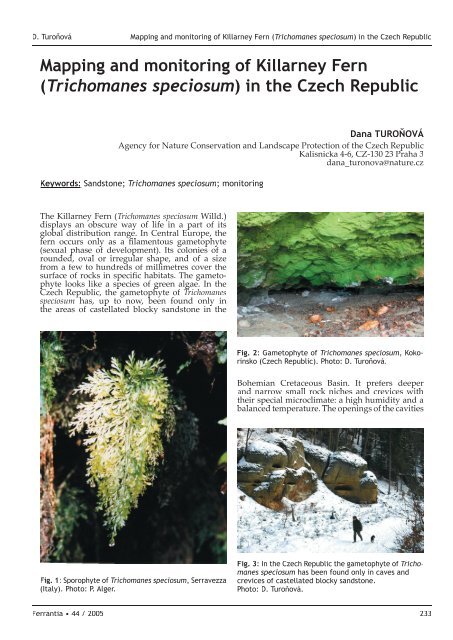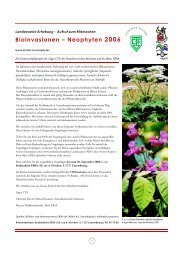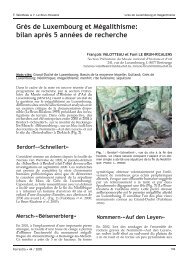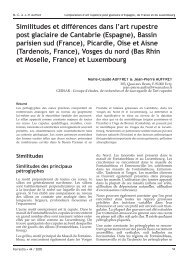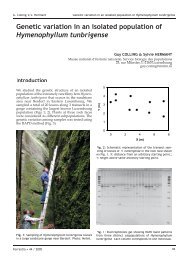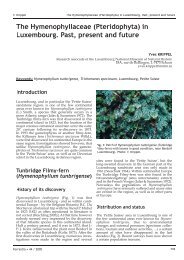(Trichomanes speciosum) in the Czech Republic
(Trichomanes speciosum) in the Czech Republic
(Trichomanes speciosum) in the Czech Republic
You also want an ePaper? Increase the reach of your titles
YUMPU automatically turns print PDFs into web optimized ePapers that Google loves.
D. Turoňová Mapp<strong>in</strong>g and monitor<strong>in</strong>g of Killarney Fern (<strong>Trichomanes</strong> <strong>speciosum</strong>) <strong>in</strong> <strong>the</strong> <strong>Czech</strong> <strong>Republic</strong><br />
Mapp<strong>in</strong>g and monitor<strong>in</strong>g of Killarney Fern<br />
(<strong>Trichomanes</strong> <strong>speciosum</strong>) <strong>in</strong> <strong>the</strong> <strong>Czech</strong> <strong>Republic</strong><br />
Ferrantia • 44 / 2005<br />
Dana TUROŇOVÁ<br />
Agency for Nature Conservation and Landscape Protection of <strong>the</strong> <strong>Czech</strong> <strong>Republic</strong><br />
Kalisnicka 4-6, CZ-130 23 Praha 3<br />
dana_turonova@nature.cz<br />
Keywords: Sandstone; <strong>Trichomanes</strong> <strong>speciosum</strong>; monitor<strong>in</strong>g<br />
The Killarney Fern (<strong>Trichomanes</strong> ( (<strong>Trichomanes</strong> <strong>Trichomanes</strong> <strong>speciosum</strong> Willd.)<br />
displays an an obscure obscure way way of of life life <strong>in</strong> <strong>in</strong> a a part part of of its<br />
its<br />
global distribution distribution range. range. In In Central Central Europe, Europe, <strong>the</strong><br />
fern occurs only as a fi lamentous gametophyte<br />
(sexual phase phase of of development). development). Its Its colonies colonies of of a<br />
a<br />
rounded, oval oval or or irregular irregular shape, shape, and and of of a a size<br />
size<br />
from a few to hundreds of millimetres cover <strong>the</strong><br />
surface of rocks <strong>in</strong> specifi c habitats. The gametogameto- phyte looks looks like like a species of green algae. In <strong>the</strong><br />
<strong>Czech</strong> <strong>Republic</strong>, <strong>Republic</strong>, <strong>the</strong> gametophyte of<br />
<strong>Trichomanes</strong><br />
<strong>speciosum</strong> has, up to now, been found only <strong>in</strong><br />
<strong>the</strong> areas of castellated blocky sandstone <strong>in</strong> <strong>the</strong><br />
Fig. 1: Sporophyte of <strong>Trichomanes</strong> <strong>speciosum</strong>, Serravezza<br />
(Italy). Photo: P. Alger.<br />
Fig. 2: Gametophyte of <strong>Trichomanes</strong> <strong>speciosum</strong>, Kokor<strong>in</strong>sko<br />
(<strong>Czech</strong> <strong>Republic</strong>). Photo: D. Turoňová.<br />
Bohemian Cretaceous Bas<strong>in</strong>. It prefers deeper<br />
and narrow small rock niches and crevices with<br />
<strong>the</strong>ir special microclimate: a high humidity and a<br />
balanced temperature. The open<strong>in</strong>gs of <strong>the</strong> cavities<br />
Fig. 3: In <strong>the</strong> <strong>Czech</strong> <strong>Republic</strong> <strong>the</strong> gametophyte of <strong>Trichomanes</strong><br />
<strong>speciosum</strong> has been found only <strong>in</strong> caves and<br />
crevices of castellated blocky sandstone.<br />
Photo: D. Turoňová.<br />
233
D. Turoňová Mapp<strong>in</strong>g and monitor<strong>in</strong>g of Killarney Fern (<strong>Trichomanes</strong> <strong>speciosum</strong>) <strong>in</strong> <strong>the</strong> <strong>Czech</strong> <strong>Republic</strong><br />
234<br />
Fig. 4: Distribution of <strong>Trichomanes</strong> <strong>speciosum</strong> – <strong>Czech</strong><br />
Vascular Plant Red Data Book 1999.<br />
are covered by mosses and algae: <strong>the</strong> colonies of<br />
<strong>the</strong> Killarney Killarney Fern Fern gametophytes gametophytes grow grow deeper deeper <strong>in</strong><br />
dusk. The The Killarney Killarney Fern Fern was was fi fi rst recorded <strong>in</strong><br />
<strong>the</strong> <strong>Czech</strong> <strong>Republic</strong> quite recently <strong>in</strong> <strong>the</strong> Ceske<br />
Svycarsko – Bohemian Switzerland (Vogel<br />
et al.<br />
1993) and it was subsequently <strong>in</strong>cluded <strong>in</strong> <strong>the</strong><br />
<strong>Czech</strong> Vascular Plant Plant Red Red Data Data Book (Cerovsky<br />
et al. . 1999). The Agency for Nature Conservation<br />
Fig. 5: <strong>Trichomanes</strong> <strong>speciosum</strong>. Harasov 9/2001.<br />
Photo: D. Turoňová.<br />
Fig. 6: Distribution of <strong>Trichomanes</strong> <strong>speciosum</strong> <strong>in</strong> <strong>the</strong><br />
<strong>Czech</strong> <strong>Republic</strong> <strong>in</strong> 2005.<br />
and Landscape Protection of <strong>the</strong> <strong>Czech</strong> <strong>Republic</strong><br />
(AOPK CR) CR) <strong>in</strong> <strong>in</strong> its its capacity capacity of of <strong>the</strong> <strong>the</strong> coord<strong>in</strong>ator coord<strong>in</strong>ator of<br />
<strong>the</strong> NATURA 2000 Network has been, with <strong>the</strong><br />
assistance of <strong>Czech</strong> and also foreign botanists,<br />
study<strong>in</strong>g <strong>the</strong> plant and survey<strong>in</strong>g its distribution<br />
distribution<br />
s<strong>in</strong>ce <strong>the</strong> year year 2000<br />
2000 . At At present, about 200 localities<br />
of <strong>Trichomanes</strong> <strong>speciosum</strong> are recorded <strong>in</strong> Bohemia<br />
and registered <strong>in</strong> <strong>the</strong> database. The Kokor<strong>in</strong>sko<br />
Fig. 7: <strong>Trichomanes</strong> <strong>speciosum</strong>. Harasov 10/2004.<br />
Photo: D. Turoňová.<br />
Ferrantia • 44 / 2005
D. Turoňová Mapp<strong>in</strong>g and monitor<strong>in</strong>g of Killarney Fern (<strong>Trichomanes</strong> <strong>speciosum</strong>) <strong>in</strong> <strong>the</strong> <strong>Czech</strong> <strong>Republic</strong><br />
Fig. 8: Maximum and m<strong>in</strong>imum temperature <strong>in</strong> a colony of <strong>Trichomanes</strong> <strong>speciosum</strong> <strong>in</strong> <strong>the</strong> year 2003. Miýnský hill<br />
near Doksy (Turoňová & Alger 2004).<br />
Protected Landscape Area (Central Bohemia) has<br />
<strong>the</strong> greatest richness <strong>in</strong> <strong>the</strong> species' populations,<br />
<strong>the</strong> number number of of sites sites now already already exceed<strong>in</strong>g exceed<strong>in</strong>g 100.<br />
100.<br />
In <strong>the</strong> Kokor<strong>in</strong>sko PLA two largest colonies of<br />
<strong>Trichomanes</strong> <strong>speciosum</strong> have been recorded: each<br />
of <strong>the</strong>m cover<strong>in</strong>g more more than 1 1 square metre. O<strong>the</strong>r<br />
sites are are sca sca sca sca ered ered – – more more or or less less densely densely – – over over <strong>the</strong><br />
<strong>the</strong><br />
sandstone areas <strong>in</strong> North Bohemia, <strong>the</strong> occurrences<br />
be<strong>in</strong>g less frequent <strong>in</strong> East Bohemia. In <strong>the</strong> NE- NE-<br />
Bohemian sandstone sandstone areas areas "Adrspassko - - Teplicke<br />
skaly" and "Broumovske steny" <strong>the</strong> species most<br />
probably does does not not occur occur because because of of cold cold climate<br />
climate<br />
and lack of suitable deep rock cavities. The site <strong>in</strong><br />
<strong>the</strong> lowest lowest altitude is is <strong>in</strong> <strong>the</strong> <strong>the</strong> Kamenice Kamenice River River gorge,<br />
Ceske Svycarsko, about 130 m a.s.l. (Jessen 2001),<br />
<strong>the</strong> highest locality is situated <strong>in</strong> <strong>the</strong> Kokor<strong>in</strong>sko<br />
PLA lies 440 m a.s.l. (Alger & Turonova 2002).<br />
S<strong>in</strong>ce 2004 a monitor<strong>in</strong>g of <strong>the</strong> species´colonies<br />
has been carried out <strong>in</strong> 10 selected sites <strong>in</strong> context<br />
Fig. 9: Monitor<strong>in</strong>g plots with fi xed marks. Photo: D.<br />
Turoňová.<br />
Ferrantia • 44 / 2005<br />
of <strong>the</strong> EU requirement to report every 6 years on<br />
<strong>the</strong> status of species species <strong>in</strong> <strong>in</strong> Annexes Annexes II, II, IV IV and and V V of<br />
of<br />
<strong>the</strong> Council Directive Directive 92/43/EEC. 92/43/EEC. The The monitor<strong>in</strong>g<br />
monitor<strong>in</strong>g<br />
<strong>in</strong>cludes an an annual annual digital photography of <strong>the</strong><br />
selected and and exactly exactly defi defi ned plots followed by<br />
by<br />
analysis of changes.<br />
At two sites, m<strong>in</strong>imum and maximum tempera-<br />
tures are recorded every month <strong>in</strong> order to <strong>in</strong>ves- <strong>in</strong>ves<strong>in</strong>ves- tigate ecological demands of <strong>the</strong> species. The<br />
gametophyte of of <strong>the</strong> <strong>the</strong> Killarney Fern tolerates even<br />
relatively low temperatures below zero centi- centi- centi-<br />
grade, which which – – compared compared with with <strong>the</strong> <strong>the</strong> sporophyte<br />
sporophyte<br />
– allows allows <strong>the</strong> <strong>the</strong> species species to to survive survive <strong>in</strong> <strong>in</strong> a a much much wider<br />
wider<br />
range of distribution.<br />
Fig. 10: : Colonies of <strong>Trichomanes</strong> <strong>speciosum</strong> with rime<br />
(Kokor<strong>in</strong>sko). Photo: D. Turoňová.<br />
235
D. Turoňová Mapp<strong>in</strong>g and monitor<strong>in</strong>g of Killarney Fern (<strong>Trichomanes</strong> <strong>speciosum</strong>) <strong>in</strong> <strong>the</strong> <strong>Czech</strong> <strong>Republic</strong><br />
236<br />
References<br />
Alger P. & Turoňová D. 2002. - Dotaznik AOPK<br />
ČR pro mapovani ohrozenych druhu rostl<strong>in</strong> –<br />
NATURA 2000, <strong>Trichomanes</strong> <strong>speciosum</strong>, Skalka.<br />
Ms. Depon. <strong>in</strong> AOPK CR, Praha.<br />
Čeřovský J., Feraková V., Holub J., Maglocky S. &<br />
Prochazka F. 1999. - Cervena kniha vzacnych<br />
a ohrozenych druhu rostl<strong>in</strong> a zivocichu CR<br />
a SR, vol. 5 (Vyssi rostl<strong>in</strong>y), 453 p., Priroda,<br />
Bratislava.<br />
Jessen S. 2001. - Dotaznik AOPK CR pro mapovani<br />
ohrozenych druhu rostl<strong>in</strong> – NATURA 2000,<br />
Résumé de la présentation<br />
Le Thrichomane remarquable (<strong>Trichomanes</strong> <strong>speciosum</strong>)<br />
mène une vie plutôt discrète dans une partie de son aire<br />
de distribution globale. En Europe centrale, la fougère<br />
est présente uniquement sous forme de gamétophyte<br />
fi lamenteux (phase sexuelle du développement). Ses<br />
colonies d’une forme arrondie, ovale ou irrégulière, et<br />
d’une taille variant de quelques millimètres à plusieurs<br />
centa<strong>in</strong>es de millimètres couvrent la surface des roches<br />
dans des habitats spécifi ques. Le gamétophyte ressemble<br />
à une espèce d’algue verte.<br />
En République Tchèque, le gamétophyte de <strong>Trichomanes</strong><br />
<strong>speciosum</strong> a été découvert, jusqu’ici, uniquement dans les<br />
régions de grès crénelé dans le bass<strong>in</strong> crétacé de Bohème.<br />
Il préfère les petites niches et les crevasses étroites et<br />
profondes dans la roche avec leur microclimat spécial à<br />
humidité élevée et température équilibrée. Les bords des<br />
cavités sont recouvertes par des mousses et des algues :<br />
les colonies des gamétophytes de la Thrichomane remarquable<br />
aiment se développer en profondeur crépusculaire.<br />
C’est assez récemment que l’on découvrit pour la<br />
première fois la Trichomane remarquable en République<br />
Tchèque : dans le Ceske Svycarsko, la Suisse de Bohème<br />
(Vogel et al. 1993). L’espèce fut ensuite <strong>in</strong>troduite dans la<br />
liste rouge tchèque des plantes vasculaires (Cerovsky et<br />
al. 1999). Depuis 2000, l’agence pour la conservation de<br />
la nature et la protection du paysage de la République<br />
Tchèque (AOPK CR), ayant dans ses a ributions la<br />
coord<strong>in</strong>ation du réseau NATURA 2000, étudie l’espèce<br />
et surveille sa distribution en collaboration avec des<br />
botanistes tchèques et étrangers.<br />
Actuellement, environ 200 localités de <strong>Trichomanes</strong><br />
<strong>speciosum</strong> ont été signalées en Bohême et enregistrées dans<br />
<strong>Trichomanes</strong> <strong>speciosum</strong>, <strong>speciosum</strong> Hrensko, Ms. Depon. <strong>in</strong><br />
AOPK ČR, Praha.<br />
Turoňová D. 2002. - Vlaskatec tajemny – zajimavy<br />
pribeh nove kaprad<strong>in</strong>y. Ochrana prirody 57:48-50.<br />
Turoňová D. & Alger P. 2004. - Vysledky monitor<strong>in</strong>gu<br />
vlaskatce tajemneho (<strong>Trichomanes</strong><br />
<strong>speciosum</strong>) za rok 2004. Ms. Depon. <strong>in</strong> AOPK<br />
CR, Praha.<br />
Vogel J. C., Jessen S., Gibby M., Jermy A. C. & Ellis<br />
L. 1993. - Gametophytes of <strong>Trichomanes</strong> <strong>speciosum</strong><br />
Willd. (Hymenophyllaceae, Pteridophyta) <strong>in</strong><br />
Central Europe. Fern Gaze e 14: 227-232.<br />
Cartographie et monitor<strong>in</strong>g de la Thrichomane remarquable (<strong>Trichomanes</strong> <strong>speciosum</strong>)<br />
en République Tchèque<br />
Mots-clés: Grès; <strong>Trichomanes</strong> <strong>speciosum</strong><br />
la base de données. Le paysage protégé de Kokor<strong>in</strong>sko<br />
(Bohême centrale) héberge la plus grande densité de<br />
stations : on y dénombre désormais plus de 100 sites pour<br />
l’espèce. C’est également dans ce e région que se situent<br />
les colonies les plus étendues de <strong>Trichomanes</strong> <strong>speciosum</strong>,<br />
chacune d’elles couvrant une surface excédant le mètre<br />
carré. D’autres stations sont dispersées – à plus ou mo<strong>in</strong>s<br />
forte densité – à travers les régions gréseuses en Bohême<br />
du nord, elles sont mo<strong>in</strong>s fréquentes dans la partie Est de<br />
la Bohême. Dans les régions gréseuses du nord-ouest de<br />
la Bohème, Adrspassko - Teplicke skaly et Broumovske<br />
steny, l’espèce est absente probablement en raison du<br />
climat froid et du manque de cavités profondes appropriées<br />
dans les roches. La station la plus basse se situe<br />
dans la gorge du fl euve Kamenice, Ceske Svycarsko, à<br />
environ 130 m (Jessen 2001), la station la plus élevée se<br />
trouvant à 440 m dans le paysage protégé de Kokor<strong>in</strong>sko<br />
(Alger & Turonova 2002).<br />
Depuis 2004 un monitor<strong>in</strong>g des colonies de l’espèce est<br />
eff ectué sur une sélection de 10 stations dans le cadre des<br />
a entes communautaires de faire tous les 6 ans rapport<br />
sur le statut des espèces reprises aux annexes II, IV, V de<br />
la directive du Conseil 92/43/EEC. Le monitor<strong>in</strong>g <strong>in</strong>clut<br />
une photographie annuelle des surfaces exactement<br />
délimitées avec un appareil numérique a<strong>in</strong>si qu’une<br />
évaluation cont<strong>in</strong>ue des changements. Dans deux<br />
stations, un enregistrement mensuel de la température<br />
m<strong>in</strong>imale et maximale permet d’étudier les exigences<br />
écologiques de l’espèce. Le gamétophyte du Thrichomane<br />
remarquable tolère même des températures relativement<br />
basses <strong>in</strong>férieures à 0°C, ce qui, - comparé au sporophyte<br />
– lui permet de survivre dans une aire de distribution<br />
beaucoup plus large.<br />
Ferrantia • 44 / 2005


